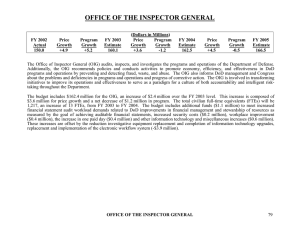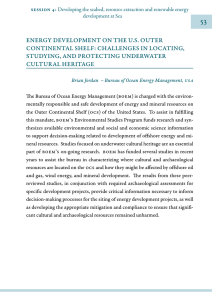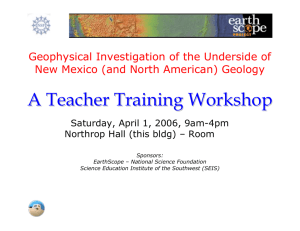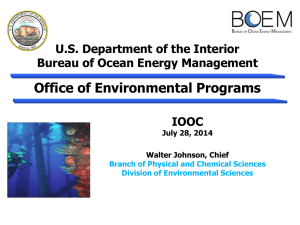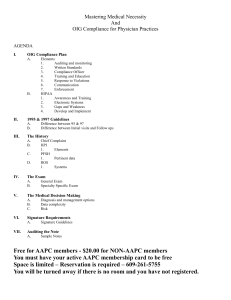1 Office of the Executive Secretariat and Regulatory Affairs February
advertisement
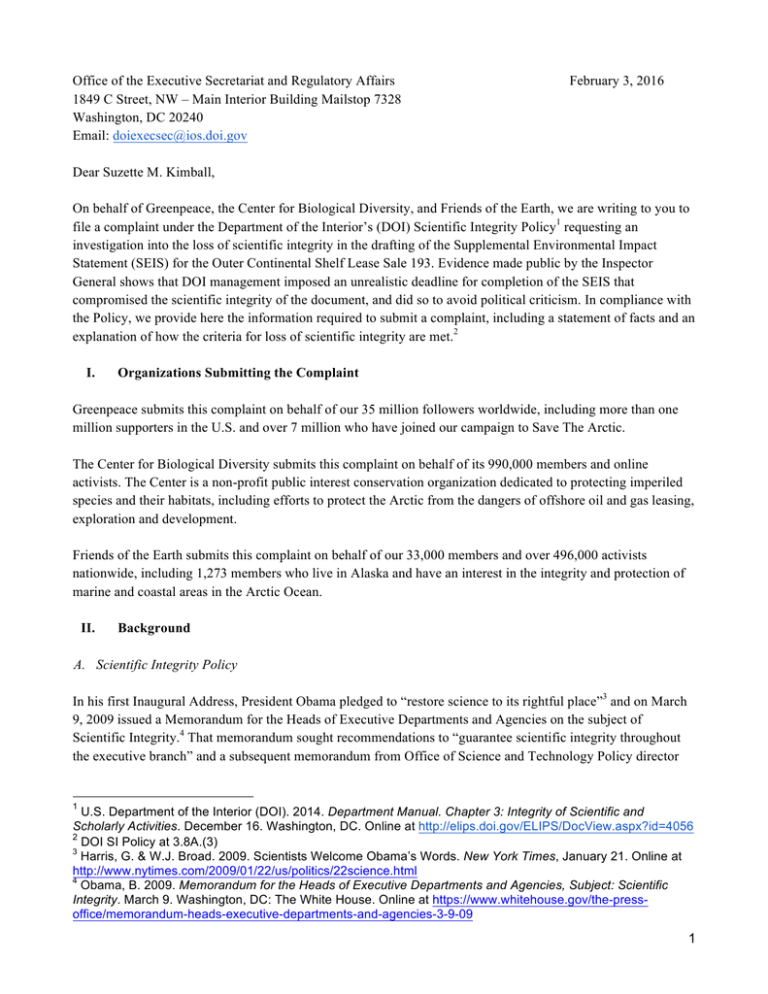
Office of the Executive Secretariat and Regulatory Affairs 1849 C Street, NW – Main Interior Building Mailstop 7328 Washington, DC 20240 Email: doiexecsec@ios.doi.gov February 3, 2016 Dear Suzette M. Kimball, On behalf of Greenpeace, the Center for Biological Diversity, and Friends of the Earth, we are writing to you to file a complaint under the Department of the Interior’s (DOI) Scientific Integrity Policy1 requesting an investigation into the loss of scientific integrity in the drafting of the Supplemental Environmental Impact Statement (SEIS) for the Outer Continental Shelf Lease Sale 193. Evidence made public by the Inspector General shows that DOI management imposed an unrealistic deadline for completion of the SEIS that compromised the scientific integrity of the document, and did so to avoid political criticism. In compliance with the Policy, we provide here the information required to submit a complaint, including a statement of facts and an explanation of how the criteria for loss of scientific integrity are met.2 I. Organizations Submitting the Complaint Greenpeace submits this complaint on behalf of our 35 million followers worldwide, including more than one million supporters in the U.S. and over 7 million who have joined our campaign to Save The Arctic. The Center for Biological Diversity submits this complaint on behalf of its 990,000 members and online activists. The Center is a non-profit public interest conservation organization dedicated to protecting imperiled species and their habitats, including efforts to protect the Arctic from the dangers of offshore oil and gas leasing, exploration and development. Friends of the Earth submits this complaint on behalf of our 33,000 members and over 496,000 activists nationwide, including 1,273 members who live in Alaska and have an interest in the integrity and protection of marine and coastal areas in the Arctic Ocean. II. Background A. Scientific Integrity Policy In his first Inaugural Address, President Obama pledged to “restore science to its rightful place”3 and on March 9, 2009 issued a Memorandum for the Heads of Executive Departments and Agencies on the subject of Scientific Integrity.4 That memorandum sought recommendations to “guarantee scientific integrity throughout the executive branch” and a subsequent memorandum from Office of Science and Technology Policy director 1 U.S. Department of the Interior (DOI). 2014. Department Manual. Chapter 3: Integrity of Scientific and Scholarly Activities. December 16. Washington, DC. Online at http://elips.doi.gov/ELIPS/DocView.aspx?id=4056 2 DOI SI Policy at 3.8A.(3) 3 Harris, G. & W.J. Broad. 2009. Scientists Welcome Obama’s Words. New York Times, January 21. Online at http://www.nytimes.com/2009/01/22/us/politics/22science.html 4 Obama, B. 2009. Memorandum for the Heads of Executive Departments and Agencies, Subject: Scientific Integrity. March 9. Washington, DC: The White House. Online at https://www.whitehouse.gov/the-pressoffice/memorandum-heads-executive-departments-and-agencies-3-9-09 1 John Holdren directed each department and agency to establish a Scientific Integrity Policy.5 On January 28, 2011, DOI became the first department or agency in the federal government to release a Scientific Integrity Policy.6 The purpose of the DOI Scientific Integrity Policy is to “provide Department-wide policy to guide and ensure the integrity of science and scientific products developed and used by the Department.”7 In particular, the term “loss of scientific integrity” is defined in section 3.5B of the current DOI Scientific Integrity Policy as follows: Loss of Scientific Integrity. Occurs when there is a significant departure from the accepted standards, professional values, and practices of the relevant scientific community, including (for DOI employees and covered outside parties) the DOI Code of Scientific and Scholarly Conduct and Departmental standards for the performance of scientific or scholarly activities. Improperly using scientific information (including fabrication, falsification, or plagiarism of science) for decision making, policy formulation, or preparation of materials for public information activities, can constituent a loss of integrity. Loss of scientific integrity negatively affects the quality or reliability of scientific information.8 The DOI Scientific Integrity Policy requires that complaints show how the criteria for “loss of scientific integrity” are met, including “citations or other information identifying the accepted practices of the relevant scientific community” and “an explanation of how the complained-of actions constitute a significant departure from those practices.”9 In sections III and IV we describe the facts of the case and show how they meet the criteria put forth here. B. Environmental Impact Statement for Lease Sale 193 The National Environmental Policy Act (NEPA), America’s “basic national charter for protection of the environment,”10 requires federal agencies to take a “hard look” at the environmental consequences of their actions before taking action.11 In this way, NEPA ensures that federal agencies “will have available, and will carefully consider, detailed information concerning significant environmental impacts” and that such information “will be made available to the larger [public] audience that may play a role in both the decisionmaking process and the implementation of the decision.”12 To this end, NEPA requires that all federal agencies prepare an EIS for all “major Federal actions significantly affecting the quality of the human environment.”13 In 2007, the Mineral Management Service (MMS, a former agency under DOI) finalized an EIS relating to a proposed oil and gas lease sale in the Chukchi Sea, north of 5 Holdren, J. 2010. Memorandum for the Heads of Executive Departments and Agencies, Subject: Scientific Integrity. December 10. Washington, DC: Office of Science and Technology Policy. Online at https://www.whitehouse.gov/sites/default/files/microsites/ostp/scientific-integrity-memo-12172010.pdf 6 U.S. Department of the Interior (DOI). 2011. Department Manual. Chapter 3: Integrity of Scientific and Scholarly Activities. January 28. Washington, DC. Online at https://www.whitehouse.gov/sites/default/files/department_of_the_interior_scientific_integrity_policy.pdf 7 DOI SI Policy at 3.1 8 DOI SI Policy at 3.5B 9 DOI SI Policy at 3.8A.(3) 10 40 C.F.R. § 1500.1(a). 11 Kleppe v. Sierra Club, 427 U.S. 390, 410, n. 21 (1976); 40 C.F.R. § 1500.1(a). 12 Robertson v. Methow Valley Citizens Council, 490 U.S. 332, 349 (1989). 13 42 U.S.C. § 4332(2)(C). 2 Alaska.14 Lease Sale 193 took place in February 2008, although the EIS was challenged in court. In July 2010, the U.S. District Court in Alaska remanded the EIS to the Bureau of Ocean Energy Management (BOEM, a successor agency to MMS) because the EIS was based on inadequate information and therefore failed to comply with NEPA.15 BOEM released a supplemental Environmental Impact Statement (SEIS) in August 2011. In 2012, Shell Oil undertook plans to drill for oil on the leases it acquired in Lease Sale 193. Due to the failure of a test of required oil spill response equipment, Shell did not receive permission to drill into the hydrocarbon bearing zones and ended the season only completing a “top hole.” Shell also experienced a number of mishaps during the season, concluding with its drill rig, the Kulluk, snapping its tow line while being transported in a winter storm and running aground on an Alaskan beach. These incidents led Interior Secretary Ken Salazar to halt further operations until after a formal review of Shell’s safety and management systems. That review was completed in 2013, but before Shell could return to the Chukchi the EIS was challenged in court again. In January 2014, the U.S. Court of Appeals for the Ninth Circuit found that the 1 billion barrel development and production scenario used in the 2011 SEIS was “arbitrary and capricious” and remanded it back to BOEM for revision. BOEM released a draft SEIS for public comment on October 31, 2014 and a final SEIS on February 12, 2015. The Record of Decision affirming Lease Sale 193 was released on March 31, 2015. Shell Oil’s Exploration Plan was approved by BOEM on May 11, 2015 and Shell began drilling in the Chukchi Sea on July 30, 2015. On September 28, 2015, Shell announced that it had not found sufficient quantities of oil and gas to justify further drilling and that it would be withdrawing from the U.S. Arctic “for the foreseeable future.”16 On December 7, 2015 the Office of Inspector General (OIG) for the U.S. Department of the Interior (DOI) released a report entitled Investigative Report of Management Interference With Lease 193 EIS, detailing allegations by multiple DOI employees of problems with the process of drafting the SEIS for Lease Sale 193.17 III. Statement of Facts Our complaint is based on the findings of the OIG report18 and focuses on politically-motivated management decisions which led to the loss of scientific integrity, specifically by unreasonably accelerating the timeline for completing the document and by removing the opportunity for necessary peer review, which is a widely accepted “standard, professional value and practice” of the scientific community. We are submitting this complaint because although the OIG report uncovered significant evidence for a loss of scientific integrity in drafting the SEIS, it did not apply the standards of the DOI Scientific Integrity Policy to that evidence and it did not fully address the issue in its conclusions. Given that DOI has adopted this policy to “guide and ensure the integrity of science and scientific products developed and used by the Department” it is 14 The relevant EIS documents and a timeline related to Lease Sale 193 can be found online at http://www.boem.gov/ak193/ 15 See Native Village of Point Hope v. Jewell, 740 F.3d 489 (9th Cir. 2014) (ordering District Court to remand in the EIS). 16 Shell. 2015. Shell updates on Alaska Exploration. September 28. Online at http://www.shell.com/media/newsand-media-releases/2015/shell-updates-on-alaska-exploration.html 17 Office of Inspector General (OIG). 2015. Investigative Report of Management Interference With Lease 193 EIS. December 7. Washington, DC: U.S. Department of the Interior (DOI). Online at https://www.doioig.gov/sites/doioig.gov/files/WebRedacted_MgmtInterference_Lease193EIS.pdf 18 We first learned of the apparent loss of scientific integrity upon the publication of this report, and as such, we are submitting this complaint within 60 days of the publication date. 3 the responsibility of the DOI Scientific Integrity Officers to investigate these claims and “ensure Departmental compliance with this policy.”19 Indeed, the testimony of multiple BOEM employees who told the OIG that the SEIS had been “compromised” is reason enough for DOI to open a scientific integrity investigation. To clarify, our complaint is not focused on allegations of falsification or editing of scientific conclusions, but rather on the concept of “loss of scientific integrity” as defined above. One section of the OIG report did investigate and ultimately dismiss allegations of falsification of scientific findings by DOI managers (OIG 1). In particular, the report spends several pages documenting the allegations of a former BOEM sociocultural specialist who alleged significant edits to her work (OIG 2-4). Although that incident may still merit further investigation, it is not the central pillar of this complaint. In this section we organize the evidence compiled by the OIG showing that (a) the 2014 SEIS was intended to be a significant update to the previous EIS, (b) the expedited timeline for the SEIS was unusually short, (c) the short timeline compromised the quality of the SEIS, (d) circumvented necessary peer reviews, (e) was done for political rather than legitimate management reasons, and (f) harmed the scientific capacity of the Bureau. A. The 2014 SEIS was intended to be a significant update to the previous EIS Several BOEM employees told the OIG that the task given to them by the courts entailed significant changes to the existing 2011 SEIS. A BOEM wildlife biologist told the OIG that the 2011 SEIS was “essentially a ‘spinoff’ of the original 2007 EIS” in that it used the same oil production scenario. He contrasted this with the 2014 SEIS “which required an entirely new exploration and development scenario” (OIG 5). Three separate BOEM regional supervisors affirmed this view (OIG 7-9). One regional supervisor stated that the court’s remand meant that “they needed to essentially start from scratch in preparing the SEIS” while another stated that BOEM was “essentially tasked with creating an entirely new EIS” (OIG 9). DOI Chief of Staff Tommy Beaudreau also stated that “BOEM’s new calculations would consider all available information and not just information that was available in 2007 when the original EIS was completed” (OIG 16). B. The expedited timeline for the SEIS was unusually short The OIG reports that BOEM regional staff proposed a timeline that would lead to a “projected completion date in August 2015” but that BOEM headquarters rejected their proposal and required the SEIS and the Record of Decision to be finalized by March 2015, in time for Shell to drill during the summer of 2015 (OIG 13). This decision shortened the timeline from approximately 15 months to less than 10 months -- a 33% reduction to the regional staff’s proposal. Numerous BOEM staff told the OIG that such an expedited timeline was unusually, and perhaps unprecedentedly, short. Staff said that their objections were communicated to BOEM management but they were overruled, “talked over” and told to stop their “naysaying” (OIG 5, 7, 9, 14). The wildlife biologist believed that the timeline was “too short” and that “BOEM’s regional managers and a deputy regional director all informed BOEM headquarters that the timeline could not be met” (OIG 5). A mineral leasing specialist said that the timeline was “very aggressive”, more so than for previous versions of the SEIS (OIG 5). An oceanographer said that “she had never worked on an SEIS with such a short timeline in her 26-year career” and a former fish biologist described the timeline as “crushed” (OIG 6). 19 DOI SI Policy at 3.1, 3.6A.(2) 4 In addition to complaints from BOEM staff, three BOEM regional supervisors registered their discomfort with the timeline, calling it “unreasonable” and pointing out that a “a new EIS takes approximately 2 to 3 years, not 7 months” (OIG 7-9). A program analysis officer who became the SEIS project manager warned that “the quality of the SEIS and the quality of life of the BOEM employees would both suffer under an unreasonably short timeline” (OIG 10). A lease sale supervisor called the timeline “ridiculous” and a NEPA coordinator felt the timeline was “too demanding” (OIG 11-12). C. The short timeline compromised the quality of the SEIS Crucially, numerous BOEM scientists and managers stated to the OIG that the quality of the SEIS was “significantly compromised” by the expedited timeline, often in quite forceful terms. The wildlife biologist stated that it was “unavoidable that the SEIS was significantly compromised due to this restrictive timeline” (OIG 5). A former fish biologist also said the “quality of the SEIS was significantly compromised” and, as a result of the process, “decided to retire from BOEM years earlier than she had planned so that she could regain her ‘personal and scientific integrity’” (OIG 6-7). One regional supervisor stated that “the bottom line regarding the SEIS was that her team was not provided the time needed to complete a quality product, and the document was compromised” (OIG 8). Another regional supervisor said “the overall quality of the SEIS was impacted” while a third regional supervisor “could not say he was proud of the final product” (OIG 9-10). The program analysis officer “acknowledged that several items were left out of the final SEIS due to the rush to complete the document” (OIG 10). The lease sale supervisor concluded “the SEIS was nowhere near the quality it could have been if the region had been provided the time it needed to create a quality product” (OIG 11). The NEPA coordinator claimed the final SEIS was “absolutely compromised” and “full of errors” (OIG 13). D. The short timeline circumvented necessary internal peer reviews According to several BOEM scientists and managers, the compromised quality of the SEIS took the form of rushed, incomplete or non-existent internal peer-review and consistency checks. The former fish biologist detailed the lack of time and opportunity for necessary peer-review: “She explained that she did not have enough time to review her own sections for scientific consistency, which is vital to any scientific work product. In addition, she stated that she was not provided any time to peer review other scientists’ sections to ensure consistency. The fish biologist stated that crossdiscipline consistency review is even more important than reviewing your own work because the possibilities for discrepancies are far greater. After submitting her sections for the draft SEIS in October 2014, the fish biologist said that she reviewed some sections from other disciplines and found inconsistencies in areas of water-quality chemistry between sections. She said that she wrote emails pointing out these discrepancies but was uncertain whether it was remedied because all the scientists were writing so rapidly to meet the timeline” (OIG 6). 5 Two regional supervisors confirm that the expedited timeline did not provide “ample” time for peer review. One former regional supervisor said that “she and her staff created a detailed timeline for completing the SEIS, which included due dates for each chapter and allotted time periods for in-house peer reviews. She explained that in-house peer reviews were vital to ensure consistency between the separate sections because all of the sections naturally overlap each other, but she could not allot ample time for these reviews because of the tight timeline” (OIG 8). Another regional supervisor also observed that “the timeline did not allow ample time for peer review between analysts” (OIG 9). The oceanographer who had never seen such a short timeline commented that her review had to be “pretty quick” (OIG 6). The wildlife biologist, while not using the exact phrase, raised similar concerns, stating: “the aggressive timeline resulted in little collaboration between analysts. He explained that collaboration between analysts would be crucial to developing a thorough SEIS because all of the resources being analyzed in the SEIS were interconnected. Accordingly, he believed that collaboration was paramount to completing a thorough SEIS. He said, however, that the timeline restricted his collaboration with other analysts during the entire SEIS process to only approximately 15 to 45 minutes.” The concerns about a lack of peer review were noted by the OIG and were actually put as a question to an attorney advisor working in DOI’s Office of the Solicitor: “When asked if she knew that several analysts working on the SEIS stated that they did not have time to conduct internal peer reviews of other analysts’ sections, the attorney advisor said that she was unaware of the region skipping any of the required processes in completing the SEIS” (OIG 13). E. The timeline was expedited for political reasons The unusually fast timeline for preparing the SEIS was not a constraint imposed by the courts or by statute. The OIG report makes it clear that the expedited timeline was imposed by DOI management in order to keep open the option of drilling in summer 2015, and ultimately, to avoid criticism from Shell Oil or Alaskan politicians. Multiple reports from the report indicate that BOEM staff had a strong impression that the expedited timeline was imposed in order to keep open the option of Shell drilling for oil in the Chukchi Sea in the summer of 2015. Some staff felt that the decision to approve the lease sale “had already been made before the SEIS was completed” (OIG 5, 6, 8). The deputy regional director “had heard some regional employees express the belief that headquarters rushed the timeline to complete the SEIS ‘for Shell’” resulting in “a great deal of resentment by the regional employees” (OIG 12). One regional manager said that “everyone working on the SEIS” knew that the timeline was “to allow the leaseholder, Shell, to drill during the spring and summer of 2015” (OIG 9). This was echoed by the NEPA coordinator and another regional manager who also “disagreed it was a good reason to compress the timeline” (OIG 10, 13). Perhaps as a means of clarifying their rationale for skeptical staff, both Beaudreau and DOI Assistant Secretary for Land and Minerals Management Janice Schneider stated to BOEM staff that “DOI did not want to be blamed for preventing Shell from having a drilling season in 2015” (OIG 7, 10, 14). Speaking to the OIG, BOEM Deputy Director Cruickshank and Beaudreau confirmed this rationale for the expedited timeline. 6 “Cruickshank said that he eventually learned that Beaudreau established the aggressive timeline for completing the SEIS due to Beaudreau’s fear that BOEM would become a target of the congressional delegation from Alaska and the oil and gas industry if BOEM did not complete the SEIS before the spring of 2015. According to Cruickshank, Beaudreau was concerned that DOI would be vulnerable to criticism from the State of Alaska and the local press if Shell did not have the opportunity to conduct drilling activities during the 2015 open-water season. Cruickshank confirmed that Beaudreau stated this reason for the aggressive timeline to BOEM managers working on the SEIS during a video conference call in November 2014 (OIG 15). Beaudreau also stated that “the Alaska congressional delegation, including Senator Lisa Murkowski” would criticize BOEM “if the work was not completed in a timely manner.” Beaudreau also wanted the analysis to be completed so “Shell could not blame BOEM if the company elected not to proceed in 2015 for its own internal reasons” given that industry and Congress might characterize industry failures as a “regulatory failure” (OIG 1617). F. The loss of scientific integrity has harmed BOEM’s scientific capacity One clear take-away from the OIG report is that the entire process around drafting the SEIS was highly stressful for BOEM scientific staff and ultimately harmed BOEM’s scientific capacity. Four BOEM employees told the OIG that they had resigned or retired early as a result of the SEIS process: a sociocultural specialist, a fish biologist, a regional supervisor, and a program analysis officer (OIG 4, 7, 8, 11). Beaudreau said that “as many as six employees in the Alaska OCS Region office” may have left BOEM as a result (OIG 18). Both Cruickshank and Beaudreau noted the negative impact of the process on staff morale, and Cruickshank stated that he “would never want to put the region through something like that again” (OIG 16), which only emphasizes the significant departure from normal Departmental procedures. IV. BOEM’s Process for the SEIS Demonstrates a Loss of Scientific Integrity Given the facts accumulated by the OIG and summarized above, there exists the potential for multiple instances of “loss of scientific integrity” in the process of crafting the SEIS for Lease Sale 193. For this reason, DOI must conduct a thorough investigation of the SEIS process in question. In this section, we focus on the evidence for one such violation -- insufficient time for adequate peer review -- but we do not discount the possibility that there may have been other violations as well. In this section we show that peer review is an accepted standard, professional value and practice of the relevant scientific community, and that BOEM’s circumvention of that process represented a “significant departure” from that standard. A. Peer review is an established standard, professional value and practice Peer review is widely understood to be a “cornerstone of scientific practice” that is essential for validating and ensuring the quality of scientific products.20 A 2004 Office of Management and Budget (OMB) memo established the principle that “important scientific information shall be peer reviewed by qualified specialists 20 U.S. Geological Survey. 2011. U.S. Geological Survey Manual. 502.3 - Fundamental Science Practices: Peer Review. Online at http://www.usgs.gov/usgs-manual/500/502-3.html 7 before it is disseminated by the federal government.”21 The OMB memo similarly underlines the centrality of peer review to the scientific process, stating that it is “one of the important procedures used to ensure that the quality of published information meets the standards of the scientific and technical community.” DOI also makes reference to the OMB memo in its DOI Bulletin for Peer Review, although we note that BOEM’s individual bureau peer review website remains “Under Construction.”22 The DOI’s Scientific Integrity Policy also makes mention of the importance of peer review. The policy states that individuals engaged in scientific activities ought to “welcome constructive criticism of my scientific activities”, “be responsive to peer review” and “provide constructive, objective, and professionally valid peer review of the work of others, free of any personal or professional jealousy, disputes, competition, non-scientific disagreement, or conflict of interest resulting from financial interests or personal or business relationships.”23 The policy further emphasizes the responsibility of DOI decision-makers to support peer review, stating that decision makers will “offer respectful, constructive, and objective review of scientific activities of employees I supervise and will encourage them to obtain appropriate peer reviews of their work.”24 B. The SEIS process was a “significant departure” from normal peer review standards The testimonials provided by multiple BOEM scientists, scientific managers and staff members to the OIG demonstrate that the expedited timeline for drafting the SEIS was highly unusual and led directly to a compromised document. BOEM employees set forth a plan that represented the “accepted” procedure for completing an EIS, which included sufficient time for peer review and internal consistency checks. As the OIG found, this plan was overruled for political reasons, and Department leadership imposed a timeline that was five months shorter. The departure from the accepted procedure is “significant” in the sense of the DOI Scientific Integrity Policy because BOEM scientists and managers made a direct connection between the expedited timeline and the compromised nature of the document. In other words, the departure is “significant” because it led to a substandard final product as judged by BOEM’s appointed subject matter experts. Peer review is, of course, designed to prevent exactly this sort of problem, and it is clear that if BOEM had been able to complete the EIS on its original timeline with sufficient time for peer review, then the deficiencies identified by BOEM scientists and managers could have been avoided. The OIG specifically did not “assess or opine on the scientific quality of the SEIS,” instead relying on a review by the U.S. Environmental Protection Agency (EPA) which found that the SEIS contained “adequate information” (OIG 1). However, the EPA finding of “adequate information” is not a reliable guide to the overall scientific integrity of the document. The EPA likely did not have access to BOEM staff concerns about the process, and is unlikely to have the depth of specific subject matter knowledge that BOEM’s experts have. Moreover, the DOI Scientific Integrity Policy puts forth an entirely different standard for assessing “loss of scientific integrity.” The EPA did not analyze this Policy or standard in reaching its conclusion. 21 Bolten, J. B. 2004. Memorandum for Heads of Departments and Agencies. Subject: Issuance of OMB’s “Final Information Quality Bulletin for Peer Review”. Washington, DC: Office of Management and Budget. Online at https://www.whitehouse.gov/sites/default/files/omb/memoranda/fy2005/m05-03.pdf 22 U.S. Department of the Interior (DOI). DOI Bulletin for Peer Review. Online at https://www.doi.gov/ocio/policymgmt-support/information-and-records-management/bureau-peer-review 23 DOI SI Policy at 3.7B.(5)-(6) 24 DOI SI Policy at 3.7C.(2) 8 V. Persons Responsible for Loss of Scientific Integrity The OIG report makes it clear that the individual responsible for the flawed process used to draft the SEIS is former BOEM director and current DOI Chief of Staff Tommy Beaudreau. It is also relevant to note that the DOI Scientific Integrity Policy puts forth a Code of Scientific and Scholarly Conduct that applies not just to scientists but to all DOI Employees, Volunteers and Outside Parties.25 That Code entrusts that DOI employees: ● ● ● ● ● VI. “will act in the interest of the advancement of science and scholarship for sound decision making, by contributing or using the most appropriate, best available, high quality scientific data and information to inform the mission of the Department.” “will be responsible for the resources entrusted to me; including equipment, funds, my time, and the employees I supervise” “will not intentionally hinder the scientific activities of others or engage in scientific misconduct.” “will be responsible for the quality of the data I use or create and the integrity of the conclusions, interpretations, and applications I make. “will adhere to appropriate quality assurance and quality control standards, and not withhold information because it might not support the conclusions, interpretations, and applications I make.” Conflicts of Interest The complainants do not have any conflicts of interest with any of the subjects, entities or situations named in this document. VII. Submission to Other Bodies The complainants have not submitted any of these facts to other offices or departments. If you have further questions please don’t hesitate to contact Timothy Donaghy at (415) 255-9221 x383, or by email at tim.donaghy@greenpeace.org. Sincerely, Timothy Donaghy, Ph.D. Senior Research Specialist Greenpeace USA 25 Kristen Monsell Staff Attorney Center for Biological Diversity Marissa Knodel Climate Campaigner Friends of the Earth DOI SI Policy at 3.7 9
